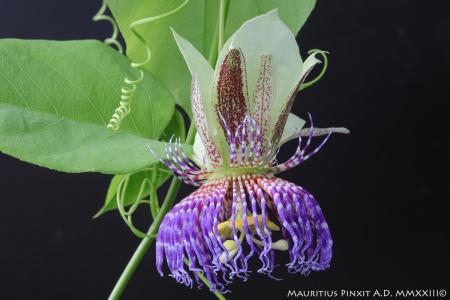
SUBGENUS: passiflora
SUPERSECTION: laurifolia
SERIES: laurifoliae
GEOGRAPHICAL DISTRIBUTION OR ORIGIN:
Venezuela, Colombia and northern Ecuador.
MINIMUM TEMPERATURE: 8 °C
IDEAL MINIMUM TEMPERATURE: 10 °C
SYNONYMS: P. caudata Gentry, P. ornata Kunth.
ETYMOLOGY: From the Latin malus (apple), apple-shaped, referring to fruits.
NOTES: Chromosomes: n=9, 2n=18
DESCRIPTION:
P. maliformis is a climber with a strong, robust, tenacious character. The flowers are large with a characteristic shape and unusual colours. Its round fruits, 5 cm in diameter, have a very hard coating. The whole leaves are narrow and sharp like the tip of a spear. The stem is light red in colour. It grows steadfastly and without hesitation, clinging easily with its tough tendrils. The plant also offers refined, delicate features that contrast pleasantly with the characteristics described above: I am referring to the delicious flavour of the fruits, similar to that of grapes, and the pleasant, light fragrance of the flowers.
The contrasting colours can be clearly seen in the flower, although they are not as bright and 'brazen' as those of other passionflowers. The large triangular bracts that surround the flower are yellow-green and end with a spike, which originates from the robust central rib of the bract itself. The sepals, consistent, narrow and tilted back, display thick brown punctuation against a yellow-green background. The petals recall the same chromatic motif, but are larger and, often, the dark rust-coloured punctuation flows into longitudinal bands. The corona of filaments, formed of various concentric series, is instead stretched forward. The filaments are initially white and purple in colour, then alternate in transverse bands of light pink and intense violet, forming a curious pictorial effect. The ends are pleasantly wavy.
P. maliformis, native to the warm areas of South America, is relatively resistant to cold; in fact, it can bear winter temperatures not lower than 4°C. It could, therefore, be adapted outdoors in the south of our peninsula and on the Ligurian Riviera.
Elsewhere, it must be grown in pots, sheltered in winter and taken outdoors during the summer. It blooms profusely during the summer. Like all creepers, it requires adequate supports that can be attached directly to the pot, or placed around its outside. Vigorous growth is achieved, for example, by burying the pot near a light fence. The plant can reach 6 metres in length; therefore, it is necessary to ensure space for it to develop in its full exuberance and produce its elegant, characteristic flowers with a shape, consistency and colouring similar to those of exotic orchids.